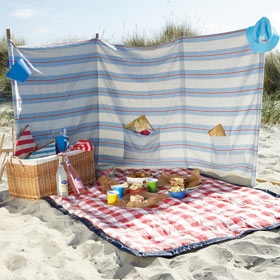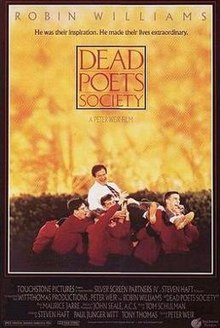My earliest memory of picnicking is on a beach surrounded by a wind break and my Dad pumping the old Primus stove to make a cup of tea. The picnic didn't consist of anything much - a few sandy cucumber and Dairylea sandwiches maybe. But I still like the idea of a picnic even though I really can't remember the last time I went on one. The ideal location for me would have to be by a river or stream, sitting in the shade of a tree on a hot summers' day. With a proper picnic basket full of special picnic food and tartan rugs to sit on and taking a snooze after lunch with wine and beer
chilling in the stream.

Of course, the best picnics seem to happen only in childrens literature.(Jane Brocket from an article in the Guardian describes )
Famous Five picnics in the series by Enid BlytonI don't mind which one because any Famous Five picnic would be high on my list of marvellous food moments. Although I have never found any reference to "lashings of ginger beer" in Enid Blyton's books, I have come across "lashings of boiled eggs". It's amazing how she manages to make hard-boiled eggs sound ultra-exciting and appealing; maybe it's the addition of the inevitable "screw of salt" which does it? Or maybe it's something to do with fresh air, freedom and the adventures that invariably follow any Famous Five picnic? Or perhaps it's the food - always "gorgeous" - that accompanies the eggs? Tomato sandwiches, lemonade, tinned sardines, melt-in-the-mouth shortbread, lettuces, radishes, Nestlé milk, ginger beer, tins of pineapple chunks, squares of chocolate. The Famous Five set a standard in picnics that has never been equalled.
Maria's tea party in The Little White Horse by Elizabeth GoudgeThere are quite a few wonderful tea parties in children's literature, but nothing can beat Maria's spectacular affair. The catering is done by Marmaduke Scarlet, the strange little cook at Moonacre who possesses almost mystical powers in the kitchen, plus the skills and artistry to conjure up all sorts of treats and delicacies at a moment's notice. A truly dedicated baker, he relishes the planning and his list what he prepares makes the reader desperate for an invitation. There's plum cake, saffron cake, meringues, Devonshire splits, almond fingers, parkin, cream horns, lemon curd sandwiches, cinnamon toast, gingerbread, eclairs and plenty more. It's a veritable litany of great British tea-time treats, and one of the most mouth-watering literary moments ever.
Robber tea in The Box of Delights by John MasefieldI have great memories of a wonderful indoor den made in winter from my Nana's card table and tablecloths, illuminated by a red light bulb taped to the underside of the tabletop (unthinkable nowadays, I suppose). My brother and I would spend hours in there, playing cards and demanding supplies of food and drink from our indulgent grandparent. But I now realise that we could have gone even further and played "robber tea" like the children in The Box of Delights. A cave-like den is created in a darkened room with table, chairs, curtains and lanterns, the fire is stoked, and out come the toasting forks, sausages, bread, butter, dripping and jam. They pretend they are robbers as they lie on the hearthrug in the glow of the fire, toasting their food before scurrying back to the den with their haul. It's a wonderfully evocative scene that blends food and imagination, and makes the whole concept of dens utterly irresistible.
Jane has also written a cook book called
Cherry Cakes and Ginger Beer which is a nostalgic look at food in childrens literature.

So what would the ideal picnic food be for me.
I could go down the pork pie, sausage roll or scotch egg route, but I would definitely have to include potato salad, chicken drumsticks and cherry tomatoes and crusty fresh bread - or maybe a selection of meats from the Deli counter.

An enduring image of the best sort of picnic comes from 'The Enchanted April' film when they were picnicking on the hillside eating fresh peaches or the scene from Swallows and Amazons:-
"She put the frying pan on the ground, and gave every one a spoon. The captain, mate and the crew of the Swallow squatted round the frying pan, and began eating as soon as the scrambled eggs, which were very hot, would let them. Mate Susan had already cut four huge slices of brown bread and butter to eat with the eggs. Then she poured out four mugs of tea, and filled them up with milk from a bottle. Then there was a big rice pudding, which had been brought with them on top of the things in one of the big biscuit tins. Then there were four big slabs of seed cake. Then there were apples all round".

"The Rat brought the boat alongside the bank, tied it up, helped awkward Mole safely ashore, and swung out the picnic basket. The Mole begged to be allowed to unpack it all by himself. He took out all the mysterious packets one by one and arranged their contents, gasping 'Oh my! Oh my!' at each fresh surprise."
The first usage of the word is traced to the 1692 edition of Tony Willis,
Origines de la Langue Française, which mentions
pique-nique as being of recent origin; it marks the first appearance of the word in print. The term was used to describe a group of people dining in a
restaurant who brought their own
wine. The concept of a picnic long retained the connotation of a meal to which everyone contributed something. Whether
picnic is actually based on the verb
piquer which means 'pick' or 'peck' with the rhyming
nique meaning "thing of little importance" is doubted; the
Oxford English Dictionary says it is of unknown provenance. (Wikipedia)
The Edwardian Picnic
This occasion was one of perpetual sunshine, flowers, youth, copious amounts of food and drink: sandwiches, cold meats, cold pies, biscuits, fruit, Pimms. Picnic food -- not simply a replica of normal fare.
There were games of croquet, cards, bawdy songs, parasols for the ladies, sedate flirtations under the oaks. The Edwardians took advantage of a new appreciation for the pleasures of leisure and the English countryside (along with improved transport -- trains and automobiles) to visit it in large numbers.
The other vital element of the experience, one which the Edwardians understood, was that one should contribute as little effort as possible towards the food. It should come to one as if a gift from the heavens. This is why carting a vehicle filled with a barbecue and most of the accoutrements of the kitchen to a park or beach to cook the outdoor meal simply won't do.
No, the ONLY thing for outdoor eating is the picnic hamper -- ideally packed by someone else. Such as
Fortnum and Mason. The legendary qualities of Fortnum's hampers was the subject of an earlier post, "
How to Travel in Culinary Style." A hamper answers quite nicely for the occasion, and since it is so difficult to get good domestic servants these days (and footmen are particularly in such short supply), it is easily portable by two people.
This excerpt was taken from
Eating Like An Edwardian
and finally, probably the most famous picnic of all
 |
Le dejeuner sur l'herbe - Edouard Manet
A book of verse beneath the bough
A loaf of bread, a jug of wine, and thou
Beside me singing in the Wilderness
Ah, wilderness were paradise enow!
(Omar Khayam) |
Here's what Elspeth Thompson has to say in her 'The Wonderful Weekend Book'.
The British seem particularly keen on picnics, whether it's a grand black tie affair with champagne at Glyndebourne, cold roast chicken and pork pies from the boot of a 4x4 at a point-to-point, or a children's birthday party in the park with cake, crisps and sausages on sticks - and plenty of umbrellas in case of a shower. We're all too happy to load up the hamper and take off to a city park or meadow in the country at the slightest excuse. Food and drink, we are prone to saying, tastes better in the open air. Even though the commonly used phrase for outdoor eating - 'al fresco' - is Italian, to a European this means an elegant table on a restaurant terrace, not lugging provisions miles through the mud to lounge uncomfortably on the ground.






















